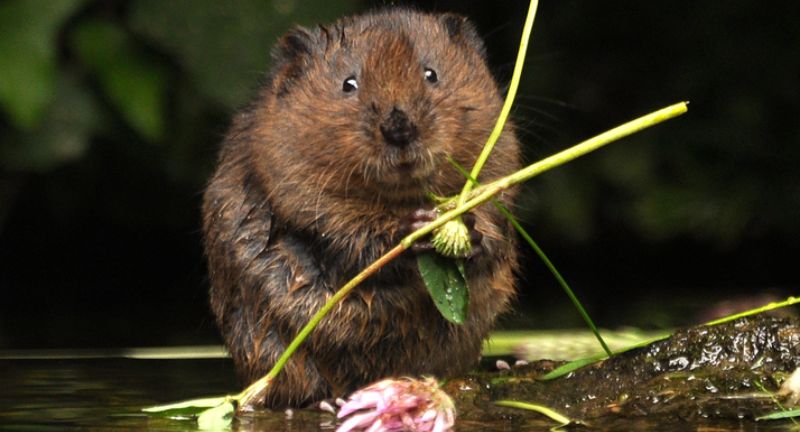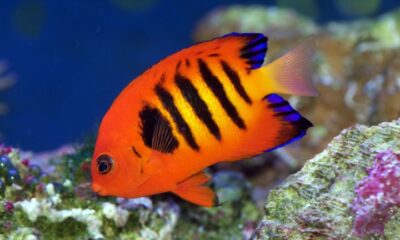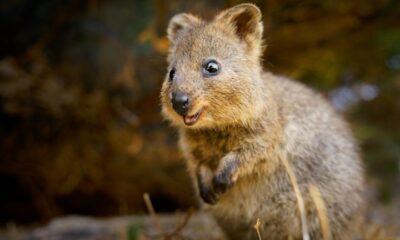Uncategorized
25 Most Beautiful Lake Dwelling Animals
Published
7 months agoon

Shutterstock
Lakes are enchanting ecosystems teeming with diverse and beautiful wildlife. From the graceful Mute Swan to the playful Otter, these habitats support a wide array of animals, each adding its own unique charm. Birds, mammals, reptiles, and even insects thrive in and around lake environments, contributing to their ecological balance. Observing these creatures in their natural habitat provides a glimpse into the delicate interplay of nature. Here are 25 of the most beautiful animals that live on lakes, each with its own story and significance.
Mute Swan

Shutterstock
Known for their graceful appearance, Mute Swans glide effortlessly across lake waters. Their long necks and white feathers make them one of the most elegant waterfowl. They are often seen forming heart shapes with their necks during courtship. These swans are also quite territorial and can be seen defending their nesting areas fiercely.
Mallard Duck

Shutterstock
Mallard Ducks are easily recognizable, especially the males with their iridescent green heads. They are highly adaptable and can be found in a variety of freshwater habitats. These ducks have a distinctive quack, which is more pronounced in females. They play an important role in the ecosystem by feeding on aquatic plants and insects.
Great Blue Heron

Shutterstock
The Great Blue Heron is a majestic bird with long legs and a lengthy neck, often seen wading through shallow waters. They have a slow, deliberate flight and can often be seen gliding gracefully over lakes. Their diet consists mainly of fish, which they skillfully catch with their sharp beaks. These birds are also known for their elaborate mating displays and large, stick-built nests.
Common Loon

Shutterstock
Common Loons are known for their haunting calls, which echo across northern lakes. They have striking black-and-white plumage and red eyes that stand out. Loons are excellent divers, capable of reaching depths of up to 200 feet to catch fish. Their presence is often a sign of a healthy, clean lake environment.
Beaver

Shutterstock
Beavers are famous for their impressive dam-building skills, which create important wetland habitats. They have strong, flat tails used for swimming and warning signals. Beavers’ work benefits many other species by creating ponds that provide homes for fish, birds, and amphibians. These industrious animals play a crucial role in maintaining the health of aquatic ecosystems.
Kingfisher

Shutterstock
Kingfishers are small, colorful birds often seen diving for fish in lakes and rivers. They have striking blue and orange plumage that makes them easy to spot. Kingfishers are known for their rapid flight and sharp beaks, which they use to catch their prey. These birds often nest in burrows dug into the banks of rivers and lakes.
Bald Eagle

Shutterstock
The Bald Eagle is an iconic bird of prey often found near large bodies of water. Known for their white heads and yellow beaks, they are a symbol of strength and freedom. Bald Eagles primarily feed on fish, which they catch with their powerful talons. These majestic birds build enormous nests, sometimes weighing hundreds of pounds, in tall trees near water.
Osprey

Shutterstock
Ospreys are another bird of prey known for diving to catch fish from lakes and rivers. They have a distinctive black eye stripe and white underparts. Ospreys are skilled hunters, often seen hovering above the water before plunging in to grab their prey. They are also known for their large, stick nests built on treetops or man-made structures.
Painted Turtle

Shutterstock
Painted Turtles are brightly colored with red and yellow markings on their shells and bodies. They are often seen basking on logs or rocks near the water’s edge. These turtles are omnivores, feeding on aquatic plants, insects, and small fish. Painted Turtles are popular in the pet trade but also thrive in the wild across North America.
Otter

Shutterstock
Otters are playful mammals often seen sliding and swimming in lakes and rivers. They have sleek, glossy fur that keeps them warm in cold water. Otters are known for their social behavior and can often be seen playing together in groups. They feed on fish, crustaceans, and other aquatic animals, making them important predators in their ecosystems.
Wood Duck

Shutterstock
Wood Ducks are exceptionally colorful and striking, with males displaying iridescent greens, purples, and whites. They are often found in wooded swamps, marshes, and ponds. Wood Ducks nest in tree cavities, sometimes quite far from water. They are excellent fliers and can be seen performing agile maneuvers in flight.
Great Crested Grebe

Shutterstock
Great Crested Grebes are elegant birds known for their elaborate courtship dances. They have striking plumage, with distinctive head crests and ruffs. These birds are excellent swimmers and divers, often seen chasing fish underwater. Great Crested Grebes build floating nests anchored to aquatic vegetation in lakes and ponds.
Northern Pike

Shutterstock
Northern Pike are sleek, predatory fish with distinctive markings and sharp teeth. They are known for their aggressive behavior and can grow to impressive sizes. Pikes are often found in the shallow, weedy parts of lakes where they ambush their prey. They are popular among anglers for their fighting spirit and large size.
American Bullfrog

Shutterstock
American Bullfrogs are large frogs with deep, resonant calls that can be heard from far away. They are the largest frog species in North America, often found near the edges of lakes and ponds. Bullfrogs are voracious predators, feeding on insects, small fish, and even other frogs. Their presence can significantly impact the local ecosystem.
Dragonfly

Shutterstock
Dragonflies are beautiful insects with iridescent wings that shimmer in the sunlight. They are often seen darting around lakes and ponds, hunting for smaller insects. Dragonflies are excellent fliers and can hover, fly backward, and change direction rapidly. Their presence indicates a healthy aquatic ecosystem, as they require clean water to thrive.
Musk Turtle

Shutterstock
Musk Turtles are small turtles with a strong odor used for defense, earning them the nickname “stinkpot.” They are often found in slow-moving waters with abundant vegetation. Musk Turtles are primarily aquatic, rarely venturing onto land except to lay eggs. Their diet includes small fish, insects, and aquatic plants.
Common Tern

Shutterstock
Common Terns are graceful birds often seen diving for fish in lakes and coastal areas. They have a distinctive black cap and forked tail. Terns are known for their agile flight and can travel long distances during migration. They nest in colonies on sandy or rocky shores, making them a common sight in coastal and freshwater habitats.
River Otter

Shutterstock
River Otters are agile swimmers with sleek, glossy fur, often seen playing and hunting in lakes and rivers. They are highly social animals, frequently seen in groups. Otters have a varied diet that includes fish, crustaceans, and amphibians. Their playful behavior and inquisitive nature make them a delight to observe in the wild.
Cormorant

Shutterstock
Cormorants are dark, long-necked birds often seen drying their wings in the sun after diving for fish. They have specialized feathers that allow them to become waterlogged, aiding their diving ability. Cormorants are expert swimmers and can chase fish underwater with remarkable agility. They often nest in colonies on cliffs or trees near water bodies.
Snowy Egret

Shutterstock
Snowy Egrets are elegant white birds with black legs and striking yellow feet. They are often seen wading through shallow waters, hunting for fish and small invertebrates. Snowy Egrets use a variety of foraging techniques, including stirring the water with their feet to flush out prey. Their graceful appearance and hunting prowess make them a favorite among bird watchers.
Mandarin Duck

Shutterstock
The Mandarin Duck is one of the most stunning and colorful ducks found around lakes. Males are particularly striking with their elaborate plumage featuring bright orange, blue, and green feathers. They are native to East Asia but can also be found in parts of Europe and North America. These ducks are often seen in pairs, and their beauty makes them a favorite among bird watchers and nature enthusiasts.
Water Vole

Shutterstock
Water Voles are small, brown rodents often seen swimming in lakes and rivers. They have a rounded nose and small ears, making them look quite endearing. Water Voles are important for maintaining healthy aquatic vegetation, as they feed on a variety of plants. Their presence indicates a well-balanced ecosystem, though they are often threatened by habitat loss and predation.
Freshwater Mussels

Shutterstock
Freshwater Mussels are bivalves with intricate shell patterns that can often be found in lake beds. They play a crucial role in filtering water and maintaining its quality. Mussels are sensitive to environmental changes and can serve as indicators of water health. Their shells also provide habitat for other aquatic organisms, making them an integral part of lake ecosystems.
European Carp

Shutterstock
European Carp are large fish with shiny scales and distinctive barbels near their mouths. They are often found in slow-moving or still waters with abundant vegetation. Carp can grow to impressive sizes and are known for their resilience in various environmental conditions. They are also popular in sport fishing due to their strength and size.
Red-eared Slider

Shutterstock
Red-eared Sliders are popular pet turtles often found in the wild with distinctive red stripes behind their eyes. They are highly adaptable and can thrive in a variety of freshwater environments. These turtles are omnivores, feeding on aquatic plants, insects, and small fish. Their vibrant markings and active behavior make them a delight to observe in their natural habitats.
Conclusion

Shutterstock
The beauty and diversity of animals that inhabit lakes are a testament to the richness of these ecosystems. From majestic birds to vibrant fish, each species plays a vital role in maintaining the ecological balance. Protecting these habitats ensures that future generations can continue to enjoy and learn from these natural wonders. By appreciating the intricate web of life in lake environments, we foster a greater understanding and respect for nature. Let us cherish and preserve these magnificent creatures and their habitats for years to come.




